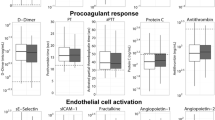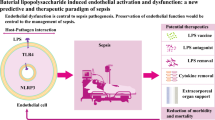Abstract
Purpose
Type 2 diabetes is associated with an increased risk of acquiring infectious diseases and developing sepsis. This may partly be due to immune dysfunction. We investigated the in vivo innate immune response of type 2 diabetic persons to an intravenous injection of E. coli lipopolysaccharide (LPS).
Methods
After ethics approval, informed consent and a thorough physical examination, 19 type 2 diabetic patients and 23 healthy controls were included. LPS was given as an intravenous bolus injection of 0.3 ng/kg. Physiological variables, white blood cell count, and plasma concentrations of tumour necrosis factor (TNF), interleukin-6 (IL-6), interleukin-1 receptor antagonist (IL-1ra), and the adhesion molecules E-selectin, vascular adhesion molecule (VCAM)-1, and intracellular adhesion molecule (ICAM)-1 were measured hourly for 8 h.
Results
LPS injection induced a systemic inflammatory response with increases in neutrophils, temperature, heart rate and plasma concentrations of cytokines and adhesion molecules in healthy and type 2 diabetic volunteers. Type 2 diabetes was associated with less pronounced LPS-induced increases in TNF, IL-1ra, VCAM-1 and ICAM-1. There was a trend towards an attenuated upregulation of E-selectin in diabetics, even though the plasma concentration tended to be generally higher compared to healthy controls.
Conclusions
Patients with type 2 diabetes exhibit an attenuated increase in plasma levels of TNF and IL-1ra, as well as an attenuated upregulation of VCAM-1 and ICAM-1 to LPS in vivo. This finding may provide a mechanistic explanation for the adverse outcome seen during infectious diseases in diabetic patients.

Similar content being viewed by others
References
Shah BR, Hux JE (2003) Quantifying the risk of infectious diseases for people with diabetes. Diabetes Care 26:510–513
Geerlings SE, Hoepelman AI (1999) Immune dysfunction in patients with diabetes mellitus (DM). FEMS Immunol Med Microbiol 26:259–265
Mooradian AD, Reed RL, Meredith KE, Scuderi P (1991) Serum levels of tumor necrosis factor and IL-1 alpha and IL-1 beta in diabetic patients. Diabetes Care 14:63–65
Hatanaka E, Monteagudo PT, Marrocos MS, Campa A (2006) Neutrophils and monocytes as potentially important sources of proinflammatory cytokines in diabetes. Clin Exp Immunol 146:443–447
Chacón MR, Vendrell J, Miranda M, Ceperuelo-Mallafré V, Megía A, Gutiérrrez C, Fernández-Real JM, Richart C, Garcia-España A (2007) Different TNFalpha expression elicited by glucose in monocytes from type 2 diabetes mellitus patients. Atherosclerosis 194:e18–e25
Delamaire M, Maugendre D, Moreno M, Le Goff MC, Allannic H, Genetet B (1997) Impaired leucocyte functions in diabetic patients. Diabet Med 14:29–34
Marhoffer W, Stein M, Maeser E, Federlin K (1992) Impairment of polymorphonuclear leukocyte function and metabolic control of diabetes. Diabetes Care 15:256–260
Katz S, Klein B, Elian I, Fishman P, Djaldetti M (1983) Phagocytotic activity of monocytes from diabetic patients. Diabetes Care 6:479–482
Notarangelo LD, Badolato R (2009) Leukocyte trafficking in primary immunodeficiencies 1. J Leukoc Biol 85:335–343
Meigs JB, Hu FB, Rifai N, Manson JE (2004) Biomarkers of endothelial dysfunction and risk of type 2 diabetes mellitus. JAMA 291:1978–1986
Lemaire LC, de Kruif MD, Giebelen IA, van Zoelen MA, van’t Veer C, van der Poll T (2008) Differential dose-dependent effects of prednisolone on shedding of endothelial adhesion molecules during human endotoxemia. Immunol Lett 121:93–96
Astrand PO, Ryhming I (1954) A nomogram for calculation of aerobic capacity (physical fitness) from pulse rate during sub-maximal work. J Appl Physiol 7:218–221
Andreasen AS, Krabbe KS, Krogh-Madsen R, Taudorf S, Pedersen BK, Moller K (2008) Human endotoxemia as a model of systemic inflammation. Curr Med Chem 15:1697–1705
Andreasen AS, Pedersen-Skovsgaard T, Mortensen OH, van HG, Moseley PL, Pedersen BK (2009) The effect of glutamine infusion on the inflammatory response and HSP70 during human experimental endotoxaemia. Crit Care 13:R7
Taudorf S, Krabbe KS, Berg RM, Pedersen BK, Moller K (2007) Human models of low-grade inflammation: bolus versus continuous infusion of endotoxin. Clin.Vaccine Immunol 14:250–255
Pickup JC, Mattock MB, Chusney GD, Burt D (1997) NIDDM as a disease of the innate immune system: association of acute-phase reactants and interleukin-6 with metabolic syndrome X. Diabetologia 40:1286–1292
Zozulinska D, Majchrzak A, Sobieska M, Wiktorowicz K, Wierusz-Wysocka B (1999) Serum interleukin-8 level is increased in diabetic patients. Diabetologia 42:117–118
Ohno Y, Aoki N, Nishimura A (1993) In vitro production of interleukin-1, interleukin-6, and tumor necrosis factor-alpha in insulin-dependent diabetes mellitus. J Clin Endocrinol Metab 77:1072–1077
Geerlings SE, Brouwer EC, Van Kessel KC, Gaastra W, Stolk RP, Hoepelman AI (2000) Cytokine secretion is impaired in women with diabetes mellitus. Eur J Clin Invest 30:995–1001
Foss-Freitas MC, Foss NT, Donadi EA, Foss MC (2006) In vitro TNF-alpha and IL-6 production by adherent peripheral blood mononuclear cells obtained from type 1 and type 2 diabetic patients evaluated according to the metabolic control. Ann NY Acad Sci 1079:177–180
Mastroeni P, Arena A, Costa GB, Liberto MC, Bonina L, Hormaeche CE (1991) Serum TNF alpha in mouse typhoid and enhancement of a Salmonella infection by anti-TNF alpha antibodies. Microb Pathog 11:33–38
Westendorp RG, Langermans JA, Huizinga TW, Elouali AH, Verweij CL, Boomsma DI, Vandenbroucke JP (1997) Genetic influence on cytokine production and fatal meningococcal disease. Lancet 349:170–173
Fujioka N, Mukaida N, Harada A, Akiyama M, Kasahara T, Kuno K, Ooi A, Mai M, Matsushima K (1995) Preparation of specific antibodies against murine IL-1ra and the establishment of IL-1ra as an endogenous regulator of bacteria-induced fulminant hepatitis in mice. J Leukoc Biol 58:90–98
Ruth JH, Bienkowski M, Warmington KS, Lincoln PM, Kunkel SL, Chensue SW (1996) IL-1 receptor antagonist (IL-1ra) expression, function, and cytokine-mediated regulation during mycobacterial and schistosomal antigen-elicited granuloma formation. J Immunol 156:2503–2509
Arnalich F, López-Maderuelo D, Codoceo R, Lopez J, Solis-Garrido LM, Capiscol C, Fernandez-Capitán C, Madero R, Montiel C (2002) Interleukin-1 receptor antagonist gene polymorphism and mortality in patients with severe sepsis. Clin Exp Immunol 127:331–336
van der Poll T, van Deventer SJ, ten Cate H, Levi M, ten Cate JW (1994) Tumor necrosis factor is involved in the appearance of interleukin-1 receptor antagonist in endotoxemia. J Infect Dis 169:665–667
Nielson CP, Hindson DA (1989) Inhibition of polymorphonuclear leukocyte respiratory burst by elevated glucose concentrations in vitro. Diabetes 38:1031–1035
Krogh-Madsen R, Moller K, Dela F, Kronborg G, Jauffred S, Pedersen BK (2004) Effect of hyperglycemia and hyperinsulinemia on the response of IL-6, TNF-alpha, and FFAs to low-dose endotoxemia in humans. Am J Physiol Endocrinol Metab 286:E766–E772
Mathur N, Pedersen BK (2008) Exercise as a mean to control low-grade systemic inflammation. Mediators Inflamm 2008:109502
Sloan RP, Shapiro PA, Demeersman RE, McKinley PS, Tracey KJ, Slavov I, Fang Y, Flood PD (2007) Aerobic exercise attenuates inducible TNF production in humans. J Appl Physiol 103:1007–1011
Vinik AI, Erbas T (2001) Recognizing and treating diabetic autonomic neuropathy. Cleve Clin J Med 68:928–944
Borovikova LV, Ivanova S, Zhang M, Yang H, Botchkina GI, Watkins LR, Wang H, Abumrad N, Eaton JW, Tracey KJ (2000) Vagus nerve stimulation attenuates the systemic inflammatory response to endotoxin. Nature 405:458–462
Shyamsundar M, McKeown ST, O’Kane CM, Craig TR, Brown V, Thickett DR, Matthay MA, Taggart CC, Backman JT, Elborn JS, McAuley DF (2009) Simvastatin decreases lipopolysaccharide-induced pulmonary inflammation in healthy volunteers. Am J Respir Crit Care Med 179:1107–1114
Wendel M, Paul R, Heller AR (2007) Lipoproteins in inflammation and sepsis II. Clinical aspects. Intensive Care Med 33:25–35
Thompson PA, Kitchens RL (2006) Native high-density lipoprotein augments monocyte responses to lipopolysaccharide (LPS) by suppressing the inhibitory activity of LPS-binding protein. J Immunol 177:4880–4887
Pickup JC (2004) Inflammation and activated innate immunity in the pathogenesis of type 2 diabetes. Diabetes Care 27:813–823
van Eijk LT, Dorresteijn MJ, Smits P, van der Hoeven JG, Netea MG, Pickkers P (2007) Gender differences in the innate immune response and vascular reactivity following the administration of endotoxin to human volunteers. Crit Care Med 35:1464–1469
Adrie C, Azoulay E, Francais A, Clec’h C, Darques L, Schwebel C, Nakache D, Jamali S, Goldgran-Toledano D, Garrouste-Orgeas M, Timsit JF, OutcomeRea Study Group (2007) Influence of gender on the outcome of severe sepsis: a reappraisal. Chest 132:1786–1793
Esper AM, Moss M, Martin GS (2009) The effect of diabetes mellitus on organ dysfunction with sepsis: an epidemiological study. Crit Care 13:R18
Puneet P, Moochhala S, Bhatia M (2005) Chemokines in acute respiratory distress syndrome. Am J Physiol Lung Cell Mol Physiol 288:L3–15
Acknowledgements
Ruth Rousing, Hanne Villumsen, Annette Vinding and Andreas Haltorp are acknowledged for their technical assistance. The Centre of Inflammation and Metabolism is supported by a grant from the Danish National Research Foundation (# 02-512-55). This study was further supported by the Beckett Foundation, the Larsen Foundation, the Foundation of Brdr. Hartmann, the Foundation of Direktør Emil Hertz og Hustru Inger Hertz, the A.P. Møller Foundation, the Foundation of the Danish Diabetes Association, the Lærdal Foundation, and the Foundation of Kong Christian den Tiende.
Conflict of interest statement
None.
Author information
Authors and Affiliations
Corresponding author
Rights and permissions
About this article
Cite this article
Andreasen, A.S., Pedersen-Skovsgaard, T., Berg, R.M.G. et al. Type 2 diabetes mellitus is associated with impaired cytokine response and adhesion molecule expression in human endotoxemia. Intensive Care Med 36, 1548–1555 (2010). https://doi.org/10.1007/s00134-010-1845-1
Received:
Accepted:
Published:
Issue Date:
DOI: https://doi.org/10.1007/s00134-010-1845-1




